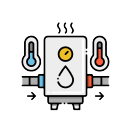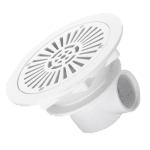Swimming pool drainage design
Designing an effective swimming pool drainage system is crucial to ensure proper water management, safety, and functionality. A well-engineered drainage system not only maintains water clarity and cleanliness but also prevents flooding, controls groundwater levels, and enhances the overall usability and longevity of the pool area. Whether for outdoor or indoor pools, residential or commercial settings, here’s a detailed exploration of swimming pool drainage design, covering key components, considerations, construction methods, and maintenance practices.
Key Components of Swimming Pool Drainage Design (Swimming pool drainage design)
- Surface Drains:
- Purpose: Surface drains are located around the perimeter of the pool deck to capture surface water runoff, rainwater, and splashed water from the pool area.
- Design Considerations: Ensure that surface drains are strategically placed to prevent standing water on the pool deck, minimizing slip hazards and maintaining a safe environment for pool users.
- Main Drain:
- Function: The main drain is located at the deepest part of the pool and serves several purposes, including water circulation, debris removal, and emergency drainage.
- Safety Features: Main drains must comply with safety regulations to prevent entrapment hazards, typically achieved through anti-entrapment covers or grates that reduce suction.
- Overflow System:
- Purpose: An overflow system prevents the pool from overflowing by directing excess water to a drainage system or collection basin.
- Design Options: Choose between perimeter overflow systems where water spills over the pool edge into a hidden channel or slot, or gutter systems where water flows into a visible gutter along the pool perimeter.
- Backwash Drain:
- Function: Used in filtration systems, the backwash drain allows for the discharge of backwashed water during pool maintenance to prevent contamination and maintain water quality.
- Connection to Wastewater System: Ensure proper connection to the wastewater disposal system to comply with local regulations and environmental standards.
Design Considerations and Construction Methods (Swimming pool drainage design)
- Hydraulic Design:
- Flow Rates: Calculate flow rates for surface drains, main drains, and overflow systems based on pool size, anticipated rainfall, and local climate conditions to prevent flooding and ensure efficient drainage.
- Pipe Sizing: Select appropriate pipe sizes and materials (e.g., PVC, ABS) for drainage pipes to accommodate expected water volumes and minimize friction losses.
- Grading and Slope:
- Pool Deck: Design the pool deck with a slight slope (typically 1-2%) away from the pool edge towards drainage points to facilitate water runoff and prevent puddling.
- Surrounding Area: Ensure proper grading of the surrounding landscape to direct stormwater away from the pool area and prevent water accumulation around the pool structure.
- Waterproofing and Sealing:
- Pool Shell: Apply effective waterproofing membranes or coatings to the pool shell and surrounding structures to prevent water penetration, potential leaks, and structural damage.
- Expansion Joints: Install expansion joints between the pool deck and adjacent structures to accommodate thermal expansion and prevent cracking, ensuring long-term durability.
Materials and Drainage System Components (Swimming pool drainage design)
- Drain Covers and Grates:
- Safety Features: Select drain covers and grates that comply with safety standards to prevent entrapment of swimmers, particularly for main drains and suction outlets.
- Aesthetic Considerations: Choose covers and grates that blend with the pool design and deck materials while maintaining functionality and safety.
- Catch Basins and Collection Pits:
- Function: Use catch basins or collection pits to collect and temporarily store drainage water before it is discharged into the sewer or drainage system.
- Maintenance Access: Ensure easy access for cleaning, inspection, and maintenance of catch basins to prevent clogging and maintain optimal drainage performance.
Maintenance and Operational Considerations (Swimming pool drainage design)
- Regular Inspections:
- Drainage Components: Conduct routine inspections of drains, grates, and pipes to ensure they are clear of debris, free from damage, and functioning properly.
- Water Quality: Monitor water quality and clarity regularly to identify potential drainage issues, such as inadequate circulation or filtration, which can impact pool hygiene.
- Debris Management:
- Leaf Traps: Install leaf traps or skimmer baskets to capture leaves, twigs, and other debris before they enter the drainage system and potentially cause blockages.
- Cleaning Protocols: Implement cleaning protocols for pool decks, drains, and surrounding areas to maintain cleanliness and prevent debris buildup that could affect drainage efficiency.
Environmental Considerations and Sustainability (Swimming pool drainage design)
- Water Conservation: (Swimming pool drainage design)
- Reuse Systems: Implement systems to capture and reuse backwash water or overflow water for irrigation purposes, promoting water conservation and sustainability.
- Natural Filtration: Consider incorporating natural filtration systems such as bioswales or vegetated buffers around the pool area to filter stormwater runoff before it enters drainage systems.
- Energy Efficiency:
- Solar-powered Systems: Utilize solar-powered pumps or filtration systems to reduce energy consumption and operational costs associated with pool drainage and water circulation.
- LED Lighting: Install energy-efficient LED lighting for drainage areas and pool surroundings to minimize electricity usage and enhance nighttime safety and visibility.
- Swimming pool drainage design is a critical aspect of pool construction that ensures proper water management and hygiene. Effective drainage systems prevent water accumulation around the pool area, protecting both the pool structure and the surrounding landscape.
- 1. Types of Drainage Systems
- There are several types of drainage systems to consider. Perimeter drains are installed around the pool’s edge to collect excess water and direct it away from the pool area. Main drains located at the bottom of the pool help circulate water and maintain cleanliness, while deck drains collect runoff from the surrounding deck.
- 2. Proper Slope and Grading
- To facilitate effective drainage, proper slope and grading are essential. The pool deck should be sloped away from the pool, ideally at a 1-2% gradient, to ensure water flows toward the drainage system. This helps prevent water from pooling around the edges, reducing the risk of slip hazards and structural damage.
- 3. Regular Maintenance
- Maintaining the drainage system is crucial for optimal performance. Regularly inspect and clean drains to prevent blockages from debris, leaves, or algae. This not only ensures proper water flow but also enhances the overall hygiene of your swimming pool.
Conclusion
Designing an effective swimming pool drainage system involves careful planning, hydraulic calculations, and compliance with safety and environmental regulations to ensure optimal performance and user safety. By integrating surface drains, main drains, overflow systems, and backwash drains with appropriate materials, safety features, and maintenance protocols, swimming pool drainage designs can effectively manage water flow, maintain water quality, and enhance the overall functionality and longevity of the pool environment. Whether for residential backyard pools, commercial facilities, or institutional settings, a well-designed drainage system contributes to a safe, clean, and enjoyable swimming experience year-round.


















